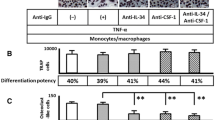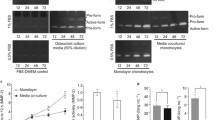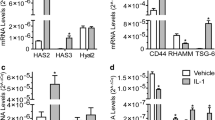Abstract
Inflammatory cytokines like interleukin-1 (IL-1) and tumor necrosis factor-alpha (TNF-α) are linked to abnormal cartilage and bone loss in a variety of pathological conditions. We have investigated the effect of TNF-α on the synthesis and/ or steady-state mRNA levels of collagen, alkaline phosphatase (ALP), plasminogen activators (PAs) and their inhibitor PAI-1, and collagenases (MMPs) and their inhibitor TIMP-1 by human osteoblastic, HOS TE85, cells in monolayer cultures. HOS TE85 cells possess ∼2000 TNF-α receptors per cell with aK d value of 0.67 nM and receptor of ∼ 60 kDa. TNF-α enhances urokinase-plasminogen activator (u-PA) activity and steady-state mRNA levels twofold without affecting tissue-plasminogen activator (t-PA) or PAI-1. The increase in u-PA mRNA is due to enhanced transcription of this gene. mRNA levels or activities of collagenase 1 (MMP-1), 72- and 92-kDa gelatinases (MMP-2 and MMP-9) are also nearly doubled with little change in the level of expression of TIMP-1. TNF-α does not significantly affect the activity or mRNA levels of ALP. TNF-α decreases collagen as well as general protein synthesis. However, the steady-state mRNA for the α2 chain of collagen type I is increased three- to fourfold. These results show that TNF-α may increase pathological bone turnover by enhancing the rate of transcription of proteases capable of degrading the nonmineralized osteoid layer and decelerating the maturation of the extracellular matrix formed by osteoblasts.
Similar content being viewed by others
References
Le, J., andJ. Vilcek. 1987. Tumor necrosis factor and Interleukin 1: Cytokines with multiple overlapping biological activities.Lab. Invest. 56:234–248.
Camussi, G., E. Albano, C. Tetta, andF. Bussolino. 1991. The molecular action of tumor necrosis factor-α.Eur. J. Biochem. 202:3–14.
Rosenblum, M. G., andN. J. Donato. 1989. Tumor necrosis factor α: A multifaceted peptide hormone.Crit. Rev. Immunol. 9:21–44.
Hohmann, H.-P., R. Remy, M. Brockhaus, andA. P. Van Loon. 1989. Two different cells types have different major receptors for human tumor necrosis factor.J. Biol. Chem. 264:14927–14934.
Brockhaus, M., H. J. Schoenfeld, E. J. Schlaeger, W. Hunziker, W. Leslauer, andH. Loetscher. 1990. Identification of two types of tumor necrosis factor receptors on human cell lines by monoclonal antibodies.Proc. Natl. Acad. Sci. U. S. A. 87:3127–3131.
Alvaro-Garcia, J. M., N. J. Zvaifler, C. B. Brown, K. Kaushansky, andG. S. Firestein. 1991. Cytokines in chronic inflammatory arthrities. IV. Analysis of the synovial cells involved in granulocyte-macrophage colony-stimulating factor production and gene expression in rheumatoid arthritis and its regulation by IL-1 and tumor necrosis factor-α.J. Immunol. 146:3365–3371.
Sugarman, B. J., B. B. Aggarwal, P. E. Hass, I. S. Figari, M. A. Palladino, Jr., andH. M. Shepard. 1985. Recombinant human tumor necrosis factor-α: Effects of proliferation of normal and transformed cells in vitro.Science 230:943–945.
Lewis, G. D., B. B. Aggarwal, T. E. Eessalu, B. J. Sugarman, andH. M. Shepard. 1987. Modulation of the growth of transformed cells by human tumor necrosis factor-α and interferon-γ.Cancer Res. 47:5382–5385.
Bertolini, D. R., G. E. Nedwin, T. S. Bringman, D. D. Smith, andG. R. Mundy. 1986. Stimulation of bone resorption and inhibition of bone formation in vitro by human tumor necrosis factor.Nature 319:516–518.
Akira, S., T. Hirano, T. Taga, andT. Kishimoto. 1990. Biology of multifunctional cytokines: IL-6 and related molecules (IL-1 and TNF).FASEB J. 4:2860–2867.
Rossomando, E. F., J. E. Kennedy, andJ. Hadjimichael. 1990. Tumor necrosis factor alpha in gingival crevicular fluid as a possible indicator of periodontal disease in humans.Arch. Oral Biol. 35:431–434.
Alvaro-Garcia, J. M., N. J. Zvaifler, andG. S. Firestein. 1990. Cytokines in chronic inflammatory arthritis. V. Mutual antagonism between interferon-gamma and tumor necrosis factor-alpha on HLA-DR expression, proliferation, collagenase production and granulocyte macrophage colony-stimulating factor production by rheumatoid arthritis synoviocytes.J. Clin. Invest. 86:1790–1798.
Duncan, M. R., andB. Berman. 1989. Differential regulation of collagen, glycosaminoglycan, fibronectin, and collagenase activity in cultured human adult dermal fibroblasts by interleukin 1-alpha and beta and tumor necrosis factor-alpha and beta.J. Invest. Dermatol. 92:699–706.
MacNaul, K. L., N. Chartrain, M. Lark, M. J. Tocci, andN. I. Hutchinson. 1990. Discoordinate expression of stromelysin, collagenase, and tissue inhibitor of metalloproteinases-1 in rheumatoid synovial fibroblasts.J. Biol. Chem. 265:17238–17245.
Lefebvre, V., C. Peeters-Joris, andG. Vaes. 1991. Production of gelatin-degrading matrix metalloproteinases (‘type IV collagenases’) and inhibitors by articular chondrocytes during their dedifferentiation by serial subcultures and under stimulation by interleukin-1 and tumor necrosis factor-α.Biochim. Biophys. Acta 1094:8–18.
Campbell, I. K., D. S. Piccoli, M. J. Roberts, K. D. Muirden, andJ. A. Hamilton. 1990. Effects of tumor necrosis factor alpha and beta on resorption of human articular cartilage and production of plasminogen activator by human articular chondrocytes.Arthritis Rheum. 33:543–552.
Canalis, E. 1987. Effects of tumor necrosis factor on bone formation in vitro.Endocrinology 121:1596–1604.
Panagakos, F. S., L. Hinojosa, andS. Kumar. 1992. TNF modulation of bone formation and bone resorption in vitro.J. Dent. Res. 71:149.
Jones, P. A., J. S. Rhim, H. Issacs, andR. M. McAlister. 1975. Relationship between tumorigenicity, growth in agar, and fibrinolytic activity in a line of human osteosarcoma cells.Int. J. Cancer 16:616–621.
Ding, A. H., E. Sanchez, S. Srimal, C. F. Nathan 1989. Macrophages rapidly internalize their tumor necrosis factor receptors in response to bacterial lipopolysaccharide.J. Biol. Chem. 264:3924–3929.
Smith, R. A., andC. Baglioni. 1989. Multimeric structure of the tumor necrosis factor receptor of HeLa cells.X Biol. Chem. 264:14646–14652.
Laemmli, U. K. 1970. Cleavage of structural proteins during the assembly of the head of bacteriophage T4.Nature 227:680–685.
Lowry, O. H., N. J. Rosebrough, A. L. Farr, andR. J. Randall. 1951. Protein measurement with the Folin phenol reagent.J. Biol. Chem. 193:265–274.
Friberger, P. 1978. Methods for the determination of plasmin, antiplasmin, and plasminogen by means of the substrate S-2251.Haemostasis 7:138–145.
Lowry, O. H., N. R. Roberts, M.-L. Wu, W. S. Hixon, andE. J. Crawford. 1953. The quantitative histochemistry of brain; enzyme measurements.J. Biol. Chem. 207:19–37.
Peterkofsky, B., andD. Diegelmann. 1971. Use of a mixture of proteinase-free collagenase for the specific assay of radioactive collagen in the presence of other proteins.Biochemistry 6:988–994.
Chomczynski, P., andN. Sacchi. 1989. Single-step method of RNA isolation by guanidinium thiocyanate-phenol-chloroform extraction.Anal. Biochem. 163:156–162.
Sambrooke, J., E. F. Fritsch, andT. Maniatis. 1989. Molecular Cloning: A Laboratory Manual. Cold Spring Harbor Laboratory Press, Cold Spring Harbor.
Lefebvre, V., C. Peeters-Joris, andG. Vaes. 1990. Modulation by interleukin 1 and tumor necrosis factor α of production of collagenase, tissue inhibitor of metalloproteinase, and collagen types in differentiated and dedifferentiated articular chondrocytes.Biochim. Biophys. Acta 1052:366–378.
Guo, J. Z., andH. G. Friesen. 1991. The osteoblastic properties of human osteogenic sarcoma cell line HOS TE85 characterized by morphological, histochemical and molecular biological studies.J. Bone Min. Res. 6:S203 (abstract).
Iamura, K., D. Spriggs, andD. Kufe. 1987. Expression of TNF receptors on human monocytes and internalization of receptor bound ligand.J. Immunol. 139:2989–2992.
Heller, R. A., K. Song, N. Fan, andD. J. Chang. 1992. The p70 tumor necrosis factor receptor mediates cytotoxicity.Cell 70:47–56.
Hohmann, H.-P., R. Remy, M. Brockhaus, andA. P. G. M. Van Loon. 1989. Two different cell types have different major receptors for human tumor necrosis factor-α.J. Biol. Chem. 264:14927–14934.
Vaes, G. 1988. Cellular biology and biochemical mechanisms of bone resorption.Clin. Orthop. Relat. Res. 231:239–272.
Thomson, B. M., G. R. Mundy, andT. J. Chambers. 1987. Tumor necrosis factor α and γ induce osteoblastic cells to stimulate osteoclastic bone resorption.J. Immunol 138:775–779.
Niedbola, M. J., andM. Stein-Picarella. 1992. Tumor necrosis factor regulation of endothelial cell extracellular proteolysis: The role of urokinase plasminogen activator.Biol. Chem. Hoppe-Seyler. 373:555–566.
Marshall, B. C., Q. P. Qu, N. V. Rao, B. R. Brown, andJ. Hoidal. 1992. Pulmonary epithelial cell urokinase-type plasminogen activator. Induction by interleukin-1 and tumor necrosis factor-alpha.J. Biol. Chem. 267:11462–11469.
Hamilton, J. A., S. R. Lingelbach, N. C. Partridge, andT. J. Martin. 1984. Stimulation of plasminogen activator in osteoblast-like cells by bone-resorbing hormones.Biochem. Biophys. Res. Commun. 122:230–236.
Leloup, G., C. Peeters-Joris, M.-M. Delaisse, G. Opendakker, andG. Vaes. 1991. Tissue and urokinase plasminogen activators in bone tissue and their regulation by parathyroid hormone.J. Bone Min. Res. 6:1081–1089.
Mitchell, P. G., andH. S. Cheang. 1991. Tumor necrosis factor-α and epidermal growth factor regulation of collagenase and stromelysin in adult porcine chondrocytes.J. Cell. Physiol. 149:132–140.
Ito, A., T. Sato, T. Iga, andY. Mori. 1990. Tumor necrosis factor bifunctionally regulates matrix metalloproteinases and tissue inhibitor of metalloproteinase (TIMP) production by human fibroblasts.FEBS Lett. 269:93–95.
Ahmadzadeh, N., M. Shimgu, andN. Nobunga. 1990. The effect of recombinant tumor necrosis factor-alpha on Superoxide and metalloproteinase production by synovial cells and chondrocytes.Clin. Exp. Rheumatol. 8:387–391.
Shimmei, M., K. Masuda, T. Kikuchi, andY. Shimomura. 1989. The role of cytokines in chondrocyte mediated cartilage degradation.J. Rheumatol. (Suppl.) 18:32–34.
Shen, V., G. Kohler, J. J. Jeffrey, andW. A. Peck. 1988. Bone-resorbing agents promote and interferon-β inhibits bone cell collagenase production.J. Bone Min. Res. 3:657–666.
Partridge, N. C., J. J. Jeffrey, L. S. Ehlich, S. L. Teitelbaum, C. Fliszar, H. C. Welgus, andA. J. Kahn. 1987. Hormonal regulation of the production of collagenase and a collagenase inhibitor activity by rat osteogenic sarcoma cells.Endocrinology 120:1956–1961.
Lorenzo, J. A., C. C. Pilbeam, J. F. Kalinowski, andM. S. Hibbs. 1992. Production of both 92- and 72-kDa gelatinases by bone cells.Matrix 12:282–290.
Nanes, M. S., W. M. McKoy, andS. J. Marx. 1989. Inhibitory effect of tumor necrosis factor-alpha and interferon-gamma on deoxyribonucleic acid and collagen synthesis by rat osteosarcoma cells (ROS 17/2.8).Endocrinology 124:339–345.
Scharffetter, K., M. Heckmann, A. Hatamochi, C. Mauch, andB. Stein. 1989. Synergistic effect of tumor necrosis factor-alpha and interferon-gamma on collagen synthesis of human skin fibroblasts in vitro.Exp. Cell Res. 181:409–419.
Mauviel, A., J. Heino, V. M. Kahari, D. J. Harthmann, G. Loyau, andJ. P. Pujol. 1991. Comparative effects of interleukin-1 and tumor necrosis factor-alpha on collagen production and corresponding procollagen mRNA levels in human dermal fibroblasts.J. Invest. Dermatol. 96:243–249.
Author information
Authors and Affiliations
Rights and permissions
About this article
Cite this article
Panagakos, F.S., Kumar, S. Modulation of proteases and their inhibitors in immortal human osteoblast-like cells by tumor necrosis factor-alpha in vitro. Inflammation 18, 243–265 (1994). https://doi.org/10.1007/BF01534267
Issue Date:
DOI: https://doi.org/10.1007/BF01534267




